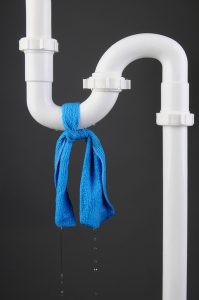If someone asked you to describe what the plumbing under your bathroom or kitchen sink looks like, you would probably mention that the drainpipe has a “U”-shaped bend to it. It’s something everyone can recognize about household plumbing but which few people think much about.
Well, we’re going to talk about that bend in the pipe, which is known as a p-trap. It’s an important part of your kitchen and bathroom plumbing and the more you know about it, the easier it’ll be to avoid problems with it.
The Purpose of the P-Trap
Although you may think of this piece of plumbing as having a “U” shape, it’s called a p-trap because when the drainpipe is detached, it does resemble a backless letter “P.” Just lay your head to the side and look at the pipe and you’ll see the shape.
But what’s the point of having a drainpipe this shape? It’s to create a trap for water flowing down the drain. Once the water turns off, gravity will trap some amount of water in the bend. This trapped water creates a barrier between the drain and the rest of the sewage system for the house. Because sewer gases naturally rise, they will move up drainpipes and out into a home unless there’s a barrier. The water in the p-trap prevents sewer gases from flowing the wrong direction into your living spaces.
The Dried P-Trap
A common problem people may run into with their plumbing is when a foul odor comes from one of the drains. This often occurs because the water in the p-trap has dried up due to lack of use. Drains in guest bathrooms or rooms that are rarely used are a frequent source of this problem. Fortunately, it’s easy to fix: you only have to run water down the drain for about a minute to restore the water in the p-trap.
Gurgling Drains
The water barrier in the p-trap can also help you identify other problems with your plumbing. If you hear a gurgling sound coming from your drains, it may be the noise of sewer gas bubbling up through the p-trap because of an increase in pressure in the sewer system. This often warns of problems with the sewer line itself that are forcing the sewer gas up through the drains. Another possible source is blocked drain vents: these vents allow sewer gas to escape easily up through the roof. If the vents are blocked, it will increase air pressure which will push the sewer gas through the p-trap.
Clogs
Although p-traps perform an important job, they can create problems as well. Along with trapping water, this bent pipe can also trap hair and soap scum, leading to clogs. A drain snake can often solve clogs in p-traps, but the more tenacious ones will require getting a professional plumber to clean the drain.
If you need help with your kitchen or bathroom plumbing in Glenview, IL to fix or replace a p-trap, you can depend on our plumbers.
For expert plumbing service, installations, or maintenance contact Reliance Plumbing Sewer & Drainage, Inc. Our knowledgeable plumbers serve the North Shore and Northwest Chicago suburbs. Rely on Reliance!

